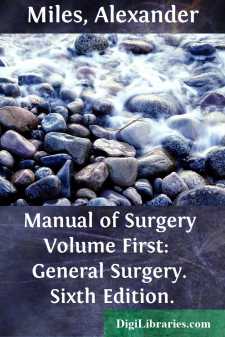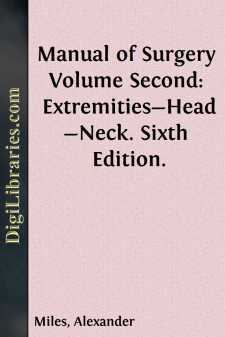Categories
- Antiques & Collectibles 13
- Architecture 36
- Art 48
- Bibles 22
- Biography & Autobiography 813
- Body, Mind & Spirit 142
- Business & Economics 28
- Children's Books 15
- Children's Fiction 12
- Computers 4
- Cooking 94
- Crafts & Hobbies 4
- Drama 346
- Education 46
- Family & Relationships 57
- Fiction 11828
- Games 19
- Gardening 17
- Health & Fitness 34
- History 1377
- House & Home 1
- Humor 147
- Juvenile Fiction 1873
- Juvenile Nonfiction 202
- Language Arts & Disciplines 88
- Law 16
- Literary Collections 686
- Literary Criticism 179
- Mathematics 13
- Medical 41
- Music 40
- Nature 179
- Non-Classifiable 1768
- Performing Arts 7
- Periodicals 1453
- Philosophy 64
- Photography 2
- Poetry 896
- Political Science 203
- Psychology 42
- Reference 154
- Religion 513
- Science 126
- Self-Help 84
- Social Science 81
- Sports & Recreation 34
- Study Aids 3
- Technology & Engineering 59
- Transportation 23
- Travel 463
- True Crime 29
Manual of Surgery Volume First: General Surgery. Sixth Edition.
by: Alexander Miles
Categories:
Description:
Excerpt
Introduction
To prolong human life and to alleviate suffering are the ultimate objects of scientific medicine. The two great branches of the healing art—Medicine and Surgery—are so intimately related that it is impossible to draw a hard-and-fast line between them, but for convenience Surgery may be defined as “the art of treating lesions and malformations of the human body by manual operations, mediate and immediate.” To apply his art intelligently and successfully, it is essential that the surgeon should be conversant not only with the normal anatomy and physiology of the body and with the various pathological conditions to which it is liable, but also with the nature of the process by which repair of injured or diseased tissues is effected. Without this knowledge he is unable to recognise such deviations from the normal as result from mal-development, injury, or disease, or rationally to direct his efforts towards the correction or removal of these.
The process of repair in living tissue depends upon an inherent power possessed by vital cells of reacting to the irritation caused by injury or disease. The cells of the damaged tissues, under the influence of this irritation, undergo certain proliferative changes, which are designed to restore the normal structure and configuration of the part. The process by which this restoration is effected is essentially the same in all tissues, but the extent to which different tissues can carry the recuperative process varies. Simple structures, such as skin, cartilage, bone, periosteum, and tendon, for example, have a high power of regeneration, and in them the reparative process may result in almost perfect restitution to the normal. More complex structures, on the other hand, such as secreting glands, muscle, and the tissues of the central nervous system, are but imperfectly restored, simple cicatricial connective tissue taking the place of what has been lost or destroyed. Any given tissue can be replaced only by tissue of a similar kind, and in a damaged part each element takes its share in the reparative process by producing new material which approximates more or less closely to the normal according to the recuperative capacity of the particular tissue. The normal process of repair may be interfered with by various extraneous agencies, the most important of which are infection by disease-producing micro-organisms, the presence of foreign substances, undue movement of the affected part, and improper applications and dressings. The effect of these agencies is to delay repair or to prevent the individual tissues carrying the process to the furthest degree of which they are capable.
In the management of wounds and other diseased conditions the main object of the surgeon is to promote the natural reparative process by preventing or eliminating any factor by which it may be disturbed.
Healing by Primary Union.—The most favourable conditions for the progress of the reparative process are to be found in a clean-cut wound of the integument, which is uncomplicated by loss of tissue, by the presence of foreign substances, or by infection with disease-producing micro-organisms, and its edges are in contact. Such a wound in virtue of the absence of infection is said to be aseptic, and under these conditions healing takes place by what is called “primary union”—the “healing by first intention” of the older writers.
Granulation Tissue.—The essential and invariable medium of repair in all structures is an elementary form of new tissue known as granulation tissue, which is produced in the damaged area in response to the irritation caused by injury or disease. The vital reaction induced by such irritation results in dilatation of the vessels of the part, emigration of leucocytes, transudation of lymph, and certain proliferative changes in the fixed tissue cells. These changes are common to the processes of inflammation and repair; no hard-and-fast line can be drawn between these processes, and the two may go on together....



